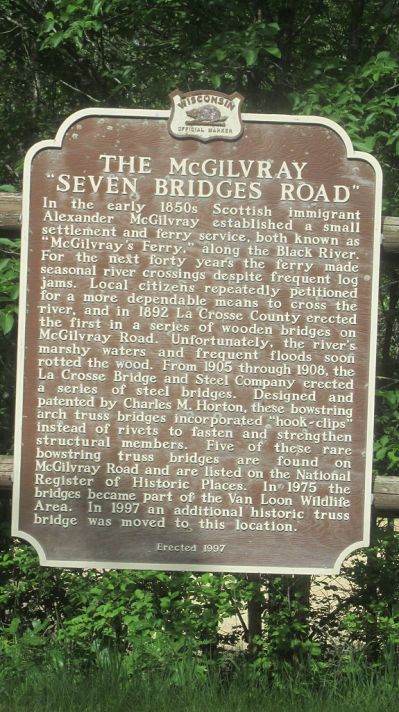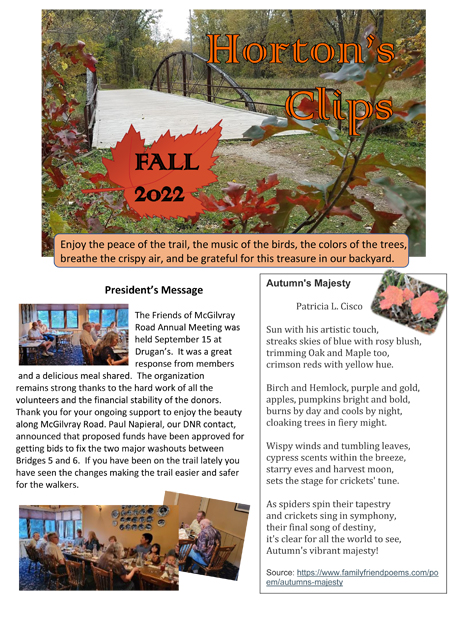
Neighbors Making History: Charles M. Horton - Bridge Builder
(written by Jeff Rand, retired Adult Services librarian)
On July 23, 1915, some men employed by a local farmer were cutting wooden poles along the bank of the Flatrock River, just northwest of Columbus, Indiana, when they made a gruesome discovery. In a small slough, underneath some large tree limbs, was the body of a man. It was so badly decomposed that the head and lower jaw fell off when the county coroner moved the body. The body was found near the Cornbrook train station, and an unused train ticket was found in the man’s pocket. Also found in his pockets were money order receipts that the coroner traced to C. M. Horton of Indianapolis, Indiana, who had been missing since July 3rd.
Charles M. Horton had briefly lived in La Crosse at the turn of the century, and he left behind some unique historical artifacts on the landscape of La Crosse County.
Charles M. Horton was born in Canadagua, New York, in the 1850s (sources differ on the exact year) to Andrew J. Horton, a blacksmith, and Louisa H. (Slover) Horton.
We know very little about his early life until his marriage to Theresa Stone on June 1, 1893, in Superior, Wisconsin. Theresa was born in Massachusetts. While living in Duluth, Minnesota, and Superior in the 1890s, Charles Horton designed and built bridges.
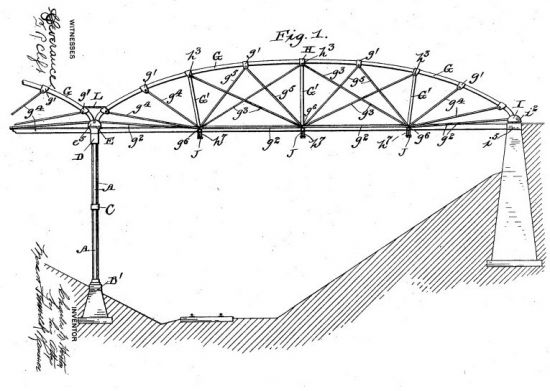
United States Patent No. 595,629 | C. M. Horton, Truss and Bridge
14 December 1897
Horton secured several patents from the United States Patent and Trademark Office related to bridge construction. One of them was for a “truss and bridge” that was patented in December 1897. His novel design featured arched top chord beams and minimized the use of rivets and bolts because Horton thought perforating the steel reduced the structural strength of a bridge. Instead, his bridge was built using splicing sleeves, hook-clips, and hangers. Horton maintained that his bridge could be assembled quickly and easily, without expensive machinery and tools, at a lower cost.
Charles and Theresa Horton moved to La Crosse in 1899. They and their two young children were renters at 509 South 9th Street. He partnered with J. F. McDonough and John A. Elliott to incorporate Horton Bridge and Steel Company. Among the stockholders were William Torrance, a partner in the Torrance steel foundry, and W. J. Solberg & Son Company, a boiler manufacturer.
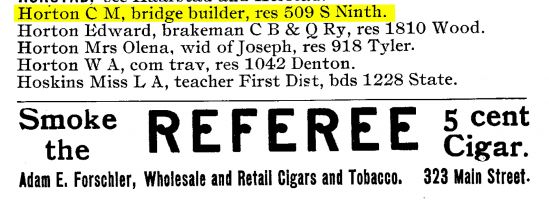
1900 La Crosse City Directory
Soon after the company was formed, it had a contract to build three steel bridges in La Crosse County. Horton Bridge and Steel also built bridges in other parts of Wisconsin and at least eleven bridges in Indiana. At the end of 1900, the company was awarded a contract to build two more iron bridges in La Crosse County to replace wooden ones that had been washed away in a big flood.
A new factory for Horton Bridge and Steel opened on August 29, 1900, next to Reliance Steam Boiler Works, owned by William J. and L. J. Solberg, at 401-403-405 Mill Street (now Copeland Avenue). The company expected to construct 25 to 35 new bridges by the end of that year.
The company underwent a total reorganization in April 1901. Charles Horton resigned as president and director of Horton Bridge and Steel, which then changed its name to La Crosse Bridge and Steel. The stockholders elected William Torrance as president, J. F. McDonough as vice president, F. E. Cutler as secretary, and John A. Elliott as treasurer. Charles Horton sold all his rights to La Crosse Bridge and Steel in exchange for royalties from the company.

1901 La Crosse City Directory
William Torrance was elected mayor of La Crosse in 1903 and re-elected for another term from 1905-1907. Soon after Torrance became mayor, he reduced his role in the bridge company, and J. F. McDonough became the president of La Crosse Bridge and Steel. McDonough remained the president until the company went out of business in 1915.
When Charles Horton left La Crosse in 1901, he was supposedly headed to Montana to establish a branch office, and then he would be going to Canada to do the same. Another newspaper reported that Horton was going to establish a bridge construction company in Vincennes, Indiana.
Horton lived in Peru, Indiana, until moving to Indianapolis in about 1907, where he was a contractor/builder. In the last years of his life, Horton was described as a traveling salesman who claimed both Chicago and Indianapolis as his home.
The same year that the La Crosse Bridge and Steel company went out of business, Charles M. Horton, who had been the founding father of the enterprise, died under puzzling circumstances in Indiana. At 9:00 a.m. on July 3, 1915, Charles Horton suddenly left his home in Indianapolis without even saying goodbye to his family. They never saw him alive again.

The Evening Republic (Columbus, OH) 24 July 1915
When his body was found beside the Flatrock River on July 23, it was identified by using the money order receipts found in a pocket. The big surprise came when Horton’s body was moved to reveal a .38-caliber pistol underneath it. One of the six rounds had been fired, and the back of Horton’s skull had a hole in it.
The coroner and police thought they had a murder case. The bullet had entered the right side of the head and came out behind the left ear. They believed it would have been difficult for the victim to have shot himself in the back of the head and have the gun come to rest under his body. They were suspicious of the way the body was positioned in the bushes and tree limbs. The coroner also noted a bone-crushing wound above the bullet hole.
In the beginning, the family insisted it had been a suicide. Deane Horton said his father had been in bad health for two years and was being treated by a physician in Columbus. Charles Horton owned a revolver, but the newspaper reports did not definitively identify the gun found as Horton’s. His son said Charles was a nervous man who did not talk much at home, “. . . and we did not talk to him.” Even so, Deane Horton said there was no reason for Charles to commit suicide unless he was in debt to the company that employed him. By contrast, his widow said that Charles had been successful in business. She soon changed her mind and thought her husband had not killed himself.
Further investigation, however, was not possible because the men who retrieved the corpse thought the coroner’s work was done, so they took the body directly to the cemetery and buried it. The coroner believed Horton had been murdered but had no clues as to who had done the deed. His conclusion: “Charles M. Horton came to his death as the result of a bullet wound at the base of the brain, said wound being inflicted by some unknown hand.”
Even though Charles Horton died over a century ago, his unique ideas for bridge construction can still be seen in La Crosse County.
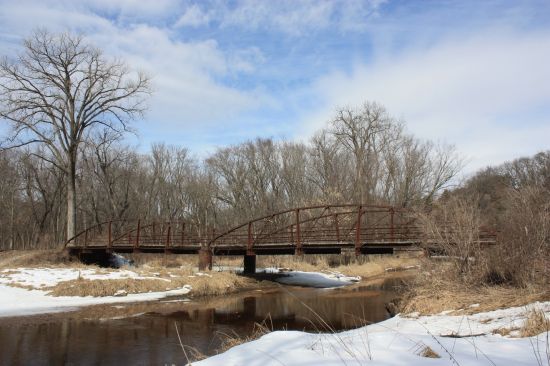
Bridge 1, McGilvray “Seven Bridges” Road; Each span shows the distinctive bowstring shape of a Horton bridge (Photo by Jeff Rand, 2023 March 8)
The La Crosse Bridge and Steel Company erected five steel bowstring arch truss bridges along the McGilvray Bottoms Road, just north of Holmen and New Amsterdam, to replace wooden bridges that had rotted. The steel bridges were constructed from 1905 through 1908 using Charles Horton’s 1897 patent.
Ironically, these historic bridges in the Van Loon Wildlife Area were once earmarked for demolition by the Department of Natural Resources. Concerned citizens petitioned the Wisconsin Legislature in the 1990s to save the bridges, and The Friends of McGilvray Road, Inc., was established to spearhead preservation and restoration. Thanks to their efforts, people can see, together in one place, five of the only six Horton bridges that remain in Wisconsin. These bridges are now on the National Register of Historic Places and the Wisconsin State Register of Historic Places.
Historic Marker at McGilvray "Seven Bridges" Road - photo courtesy of "Brad" via Flickr; click image to read closer
Bridges 1, 2, 3, 4, and 6 on the Old McGilvray Bottoms Road are Horton bowstring arch truss bridges. Bridge 5 is a different design that was moved from Pierce County, Wisconsin, in 1996, to replace a wooden bridge that had previously been in that location. Bridge 7 (not a Horton bridge) spanned the Black River and was dismantled in 1954. The only remnants of Bridge 7 are some portions of the concrete piers.
Fall 2022 issue of Horton's Clips, newsletter of The Friends of McGilvray Road; click image for full issue
If you take a stroll through the Van Loon Wildlife Refuge, over creeks, sloughs, and marshland, pause to appreciate the ingenuity and workmanship of these historic structures that have lasted for over a century. With some care, they can probably last for another century. This is the legacy of bridge builder Charles M. Horton.
WANT TO LEARN MORE?
Check out Jeff's full article here

